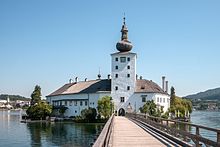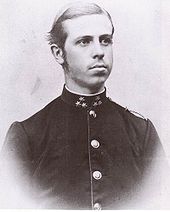Castle place
The Castle Town (until the early 20th century, Orth written) is a complex of two locks on the Traunsee and is located in the village of component place the city Gmunden in Upper Austria . It consists of the better known lake castle on an island in the Traunsee and the country castle connected via the bridge . The Seeschloss is one of the oldest buildings in the Salzkammergut . It served as the outside backdrop for the television series Schlosshotel Orth .
history
Middle Ages and early modern times (only: Seeschloss)
Schloss Ort - meaning the lake castle - was first mentioned in a document in 909 and later in 1053. Originally the castle was a moated castle, but was rebuilt in its current form after the fire in 1626. The Seeschloss is an irregular structure around a triangular courtyard with two-sided, double-storey arcades and a late Gothic outer staircase.
The first rulers of the "Veste Ort" were the Lords of Ort , Styrian ministerials. The first of them was Hartnid / Hartneid von Ort, a great-grandson of the Bavarian Count Palatine Aribo II. The Orter ruled from the 10th century until 1244, when the last of the knights was thrown into dungeon. The Seeschloss (the country castle was only built in 1634) changed the feudal lord again and again in the following time until it was passed on to the Habsburg Emperor Friedrich III in 1483 . fell, who passed it off as a (very popular) fiefdom. At the end of the 16th century the castle was bought by the town of Gmunden, which had become very rich from the salt trade. However, it had to be sold back to the Habsburg Emperor Rudolf II in 1603 because of the high maintenance costs.
17th century
In 1620 Upper Austria (the then "Land ob der Enns") was pledged to Bavaria. The Bavarian duke installed Adam Graf von Herberstorff as governor of Upper Austria in Linz . Count Herberstorff, who shortly before had married the widow of Field Marshal Veit zu Pappenheim , Maria Salome Freiin von Preysing-Kopfsburg, received the former lake palace of the Lords of Scherffenberg . In addition, he got the rule of Tollet in the Hausruckviertel , which had been withdrawn from the Protestant family of Jörger von Tollet , and made it his residence and his government headquarters . The new owner of the castle was a very cruel ruler who collected very high taxes and tithes . When the peasants tried to rebel against him for the first time, he invited all leaders for "peaceful talks" on May 15, 1625 on the Haushammerfeld near Frankenburg . After all the farmers had arrived, Count Herberstorff had 36 alleged ringleaders surrounded by his soldiers and dice one against one for their lives. This historic event went down in Austrian history as the Frankenburger Würfelspiele .
Count Herberstorff had hoped to scare the peasants with these dice games, but they were not intimidated and in 1626 the Upper Austrian Peasant Wars broke out . A total of 5000 farmers were able to entrench themselves on the Gmundener Hochkogel and win the first battle against a Bavarian-Austrian army. Highly encouraged by their victory, they attacked various noble houses in Gmunden and burned them down. The farms and stables on the site of today's country castle were also burned down. The following day the castle was attacked, looted and most of it burned down. Only sudden rains could prevent the fire from spreading further. A month later, on November 15, 1626, the peasants near Pinsdorf were crushed.
After the death of Count Herberstorff on September 11, 1629, the castle passed into the possession of his wife Maria Salome, who sold it in 1634 to her son-in-law Johann Warmund - from 1645 Count of Preysing (* 1573, † 1648) -. In 1634 the lake palace was rebuilt in its current form. In 1637 the village was raised to a county.
18th and 19th centuries
After 1690 the castle belonged again to the rulers of the Habsburg family. They employed a caretaker who managed both castles and the Ort area, but who was directly subordinate to the salt minister in Gmunden. Between the 15th century and 1848 there was also high jurisdiction within the castle walls for the area of today's Gmunden district (except for the land within the Gmunden city walls). Today three of the original four dungeon cells and the hunger tower can still be visited.
In 1867 Leopold II of Tuscany bought the Seeschloss and passed it on to his son, Archduke Johann Salvator of Austria-Tuscany . Within the next thirty years, the entire Ort area was bought by the Grand Dukes of Tuscany, who established their exile here. Archduke Johann turned away from the nobility a short time later and laid down all his titles. From then on he named himself after the castles Johann Orth and married his long-term partner, the actress Milli Stubel. In March 1890 he first traveled to La Plata with his three-master St. Margaret . The next travel destination he and his wife headed for in July 1890 was Valparaiso after circumnavigating Cape Horn . However, his ship never reached the port of destination and Johann Orth was reported missing. In 1911 he was pronounced dead and the castles reverted to the Austrian Emperor Franz Joseph .
20th century and present
In 1915 the kk Forstarkar acquired the domain. After the First World War in 1918, the castles became the property of the Federal Forests . In 1988 the Seeschloss was offered for sale and acquired in 1995 by the municipality of Gmunden for 60 million schillings. It was then renovated for 70 million schillings. The Landschloss Ort is currently a forestry training center of the Federal Ministry for Agriculture, Forestry, Environment and Water Management (FAST Ort).
Between 1996 and 2004 the castle was the scene of the successful television series Schlosshotel Orth (144 episodes of 45 minutes each), which led to some confusion among tourists , as the castle walls do not house a hotel, but only a restaurant with a wine bar.
A special feature of the castle is the clockwork from 1634, which today still has to be wound by hand every day.
Today the castle houses the Orther Stub'n restaurant and the Orther Stub'n souvenir shop . Events (concerts, readings) and up to 362 weddings a year also take place here.
The Orter Bay siltation zone in the west of the Seeschloss is under nature protection.
Traunsee with Ort Castle from 1656 by Matthaeus Merian
Country castle Ort
history
The Landschloss Ort is a square group of buildings that arose in the first half of the 17th century from the outworks of the Seeschloss. This was burned down together with the Meierhof in the Peasant Wars and then rebuilt as a castle from 1626 to 1629. Under Archduke Johann Salvator , the interior of the castle was heavily rebuilt. A hospital was housed here during the First World War . Since 1919 it has been used as a state forest school and as a seminar and congress center.
Construction
The square courtyard is marked by four towers crowned with onion helmets. On the outside there are wrought-iron window baskets from the 1st half of the 17th century. The coats of arms of the previous castle owners are placed in the inner courtyard; There is also a rococo fountain with the year 1777. The ballroom has a painted wooden coffered ceiling from 1604–1612. On the wall you can see large paintings from the 1st International Hunting Exhibition (Vienna, 1910). The stucco frames of the doors and the chimneys also come from the time the castle was built.
The castle was used as a forestry training facility until September 2018, which organizationally belongs to the Federal Research and Training Center for Forests, Natural Hazards and Landscape .
- Country castle Ort
Worth seeing in Seeschloss Ort
- Romantic courtyard in late Gothic style
- Palas (interiors)
- Wappensaal (interior)
- Church (built in 1634), dedicated to Jacob the Elder
- Starvation tower
- Dungeon cells and museum
literature
- Norbert Grabherr : Castles and palaces in Upper Austria. A guide for castle hikers and friends of home. 3rd edition . Oberösterreichischer Landesverlag, Linz 1976, ISBN 3-85214-157-5 .
- Herbert Erich Baumert & Georg Grüll : Castles and Palaces in Upper Austria, Volume 2: Salzkammergut and Alpine Foreland . Birken-Verlag, Vienna 1983, ISBN 3-85030-042-0 .
media
- Illustration by Daniel Meisner from 1626: Gmünden.Ort. Bonis nocet, qui malis parcit ( digitized version )
- Schloss Ort as a 3D model in SketchUp's 3D warehouse
Web links
- Entry via Seeschloss Ort on Burgen-Austria
- Historical review , FAST site website
Individual evidence
- ↑ Viktor von Handel-Mazzetti : Waltenstein and Eppenberg and the gentlemen "from Ort im Traunsee". In: Yearbook of the Upper Austrian Museum Association. Volume 67, Linz 1909, p. 42ff, entire article p. 1–127, PDF on ZOBODAT
- ↑ after Fritz Posch
- ↑ http://www.burgen-austria.com/archive.php?id=499
- ↑ Forest training facility site
Coordinates: 47 ° 54 ′ 41.5 " N , 13 ° 47 ′ 32.4" E












